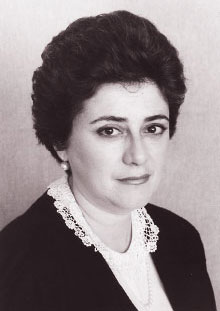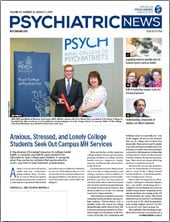That APA’s four preceding presidents were women, as are the leaders of several other specialty societies, speaks to the progress women have made in the last several decades. The president of the World Psychiatric Association is Helen Herrman, M.D., and the president of AMA is Patrice Harris, M.D., M.A.
As APA’s first woman president, elected in 1984, I am delighted but cautious—we still have a way to go. Diversity and inclusion are keys to overcoming health disparities and extending coverage to all of our patients, and those goals are dependent on the full and complete integration of women into leadership positions in medicine.
My own story is illustrative of the path women physicians of my generation traveled. I was one of only two women in a pre-medical program of 200 people at Brooklyn College, my undergraduate alma mater. It was free, and it never occurred to me that there might have been scholarship opportunities to go elsewhere, because no counselor ever suggested it to me. I applied to a number of medical schools but was accepted only at Albert Einstein College of Medicine, despite my academic record—it was better than most of my male colleagues, all of whom had multiple acceptances. Later, I transferred to the University of Rochester School of Medicine, where I was exposed to the biopsychosocial model pioneered by George Engel, M.D.
Interviewing for medical school and residency was a difficult and often unpleasant experience—discrimination was palpable and overt. I was asked questions that would be unheard of, even illegal, today.
I stayed at Rochester for my first year of residency (internship in medicine in those days), then moved on to Massachusetts Mental Health Center, and later completed my training at Beth Israel Medical Center in Boston, where the chair of psychiatry was a woman. My experience there as a resident and later as a junior faculty member at Harvard involved me increasingly in issues of reproductive rights. A few of the other women house officers and I started the first daycare center in Boston. I also helped open a rape crisis center at the hospital and other resources in the city.
At APA, I was preceded by extraordinary women pioneers who began to assert themselves during the civil rights and women’s movements in the 1960s and 1970s. Nancy Roeske, M.D., was an early leader who was a productive academic and chaired APA’s first task force on women and subsequently the Committee on Women in the early 1970s. A few women had held the office of vice president of the Association. At the 1973 and 1974 Annual Meetings, there was a substantial increase in the number of papers (from 4% to 15%) presented by women. In 1975, for the first time, child care was provided at the Annual Meeting. Rebecca Solomon, M.D., was the first woman to be appointed to the Editorial Board of the American Journal of Psychiatry. Jeanne Spurlock, M.D., was the first woman to be appointed deputy medical director of APA (1974).
Around this time the discussion about having a woman president began. I had been president of the Massachusetts Psychiatric Society (in fact, its first woman president) as well as vice president of APA, so I had some experience and visibility. Friends and colleagues, including, among others, Carolyn Robinowitz, M.D., Marcia Goin, M.D., and Elissa Benedek, M.D. (all of whom would later be elected APA president), encouraged me to run. Their support, and that of so many other APA members of both sexes, was crucial to my career and my passion to increase the diversity of APA’s leadership.
There was some resistance to having a woman president, most often framed as “timing” (as in, “it’s a good idea, but now is not the time.”) It became clear that we needed to unify to overcome it and that we would have to organize and run a national campaign (up until that time, candidates in APA elections were elected by name recognition, and there was very little campaigning). My support system helped me enormously by holding meetings in different parts of the country to meet with members.
I was quite surprised when I won. At the time, the American health care system was undergoing enormous change with the advent of managed care. Most of my presidential address in 1986 focused on my concerns about the effect on patient care of a market-based system. But I also had this to say: “Last year I indicated my expectation that in electing its first woman president, APA had moved beyond connecting gender and leadership. … But I was more optimistic than realistic. … We have much to be proud of, but the issue of equal opportunity and access remains an issue of power.”
After my presidency, I became the editor of the fledgling American Psychiatric Publishing Inc.
During my presidential year and in the years since, I befriended women leaders throughout the world, including Judy Gold, M.D., who would be president of the Canadian Psychiatric Association; Beverly Raphael, M.B.B.S., M.D., who would become president of the Royal New Zealand and Australian College of Psychiatrists; and Astrid Heiberg, M.D., who would become an influential leader in the Norwegian parliament.
Women have made great strides in psychiatry and in medicine, but to some extent what I said in 1986 remains true: Substantial gender gaps still exist in income and representation in leadership positions. Data from the Association of American Medical Colleges (AAMC) show that in 2017 there were still just 28 women chairs of departments of psychiatry compared with 121 men. In all of medicine, just 18% of academic department chairs are women. Gender bias in academic medicine has been ingrained unconsciously among both men and women: Many men who are department chiefs don’t pick women for major positions because they don’t think of women in leadership roles, and many women, in turn, don’t actively promote themselves.
Those numbers will change given the increasing representation of women in medicine. In 2018, for the second year in a row, AAMC reported that more women entered medical school than men (51.6% versus 48.3%). A total of 11,160 women matriculated in 2018, the highest figure ever.
I am proud of the progress that women have made within psychiatry in particular and medicine in general. My story is emblematic, but it is not unique; many of my women friends and colleagues have traveled the same rocky path. I hope our young women psychiatrists will become future leaders in APA and seek out other leadership positions in medicine. Our immediate past president, Altha Stewart, M.D., was wise in making diversity and inclusion prominent themes of her presidency, because these are crucial to our future. ■



